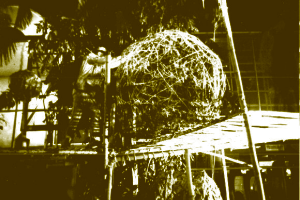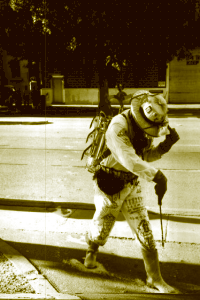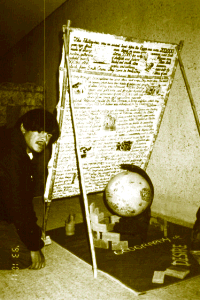Notes in Transit
Santiago Bose
 Monsoon
rains in September turn the roads in rivers and landslides block the roads
for weeks. I try to meet my appointment with the Queensland Triennial despite
the inadequate communications, poor transport system and the endless need
for money to complete my installation. Postmodern art practice in my part
of the planet is a constant test of the spirit. An artist has to be self-reliant
and creative with his situation.
Monsoon
rains in September turn the roads in rivers and landslides block the roads
for weeks. I try to meet my appointment with the Queensland Triennial despite
the inadequate communications, poor transport system and the endless need
for money to complete my installation. Postmodern art practice in my part
of the planet is a constant test of the spirit. An artist has to be self-reliant
and creative with his situation.
I was reluctant to talk about indigenous art because it institutionalizes it. The term "Philippine indigenous art" was used by art critics as a convenient name to describe contemporary art practice that is made outside Manila, where artists use local materials and merge contemporary forms with traditional modes. The mere fact that I'm writing about it makes me an accomplice to this naming. Labeling restricts mixing and reduces critical engagement. It also encourages misrepresentation of tribes who are appropriated from. Appropriation by non-tribal groups is not mixing. A deeper understanding of indigenous peoples' history reveals a wealth of knowledge. "Primitive" cultures have an understanding of art in our sense of the word. The rice terraces in the Philippines were built 2000 years ago by tribal communities without slave labour. It was an earth sculpture made collectively. Their lives, rituals, politics and economics were centered on the sculpture. Pre-hispanic Filipinos integrated art into their daily lives.
Since the voyage of Magellan, colonizers have imposed their world view and miseducated the Filipinos into believing that foreign cultures were better than their own. An investigation of our history unveils rich cultures within, misunderstood by colonizers and the population at large. Folk religion, mythology, folk theatre, rituals and fiestas were the cultural wealth of the people. These were dismissed as craft, as spiritual mumbo-jumbo, by western taste moulders and bearers of "high art." The colonizers introduced a new way of looking at their world, and created a marginalised nation that is schizophrenic - both an asset and a hindrance - with a Western education and a traditional Filipino value system. This confusion creates a tension that confronts the Filipino artist.
 The
Philippines is a developing nation of 64 million Filipinos with a scattered
geography of 7000 islands and 138 languages and dialects. Seventy percent
of the population live below the poverty line and many lack skills or training
and are unemployed. Problems of poverty, overpopulation, disorder, environmental
disasters and lack of basic services confront the Filipinos today. These
divergent cultural strains are what make national unity a distant dream.
However, cultural diversity within political autonomy can be used as strength
and inspiration for both historical understanding and a vision of our country's
unique place in the world.
The
Philippines is a developing nation of 64 million Filipinos with a scattered
geography of 7000 islands and 138 languages and dialects. Seventy percent
of the population live below the poverty line and many lack skills or training
and are unemployed. Problems of poverty, overpopulation, disorder, environmental
disasters and lack of basic services confront the Filipinos today. These
divergent cultural strains are what make national unity a distant dream.
However, cultural diversity within political autonomy can be used as strength
and inspiration for both historical understanding and a vision of our country's
unique place in the world.
The artist cannot but be affected by his society. It is hard to ignore the pressing needs of the nation while making art that serves the nation's elite. Many young artists in the regions are staking their talents to alleviate their nation's flight. This is the art, this is the challenge. This is the crystallized vision of a society in flux and constant tension. The artist is only the medium, the human lightning rod of a post-war generation of Filipino nationalists, fascists, Muslims and marginalized tribal groups, including acid heads living as (savage) monuments to a dream that haunts us all.
We struggled to change society, which is difficult and dangerous, and we also sought to preserve communal aspects of life. I too am haunted by visions of hardship, poverty, disenfranchisement of the primitive tribes, but between outbursts of violence and exploitation are also tenderness, selflessness and a sense of community. These will always remain unspoken and unrecognized unless we make art or music that will help to transform society.
The artist takes a stand through the practice of creating art. The artist articulates the Filipino subconscious so that we may be able to show a true picture of ourselves and our world. Maya Subido, an art writer, says: "In a sense, the artists are restoring art to the functions it was confirmed to in our society. A medium through which one regains wholeness and balance within, in order to be reconnected with the social collective. Thus binding their community in expressions of shared spirituality."
Today, Filipino artists are forging a modern mythology. Artists are creating visual statements of Philippine national life with blends of Spanish, American and indigenous artistic influences. "Western modernism" has liberated artists to go back to their roots and incorporate them in a contemporary vocabulary. The use of mixed media, fiber, grass, paper, bamboo and organic materials, and the use of installation, which is also rooted in traditional communities, make this art form easily acceptable to a broad range of audiences.
This debunks cultural imperialism. The training of artists in Western modes propagates the use of materials and tools that are expensive and rare. But the contemporary Filipino artist is liberated from paying the West every time he creates. The idea of art as "property" or commodity is challenged, its prominence questioned. The idea of artist as individual creator is also challenged, and a sense of community opens up new possibilities. The artist is taught to be self reliant, and using available materials and local concepts, he expands his visual vocabulary. This makes his art relevant to a broad spectrum of society, making it clear whose interest it serves. Some artists use violence through protest art.
The increasing popularity of non-traditional works such as public murals, newsletters, installation, collaborations, performances, and the existence of groups and spaces willing to underwrite these events is swaying "ART" from the exclusive control of collectors, galleries and multinational patronage. Documentation is indispensable in making these works accessible to the public.
The rise of postcolonial sentiments and postmodernism is fast eroding the myth of Western art and values. In the Philippines, the diminishing influence of Western modernism in the contemporary art scene is just starting. Artists are looking back to their history for identity and inspiration, thus democratizing art.
Regional artist collectives like the Baguio Arts Guild and other regional art organizations are flourishing all over the country. They are fast becoming the cultural vanguards of communities outside Manila. Some are impresarios for cultural shows, others are engaged in livelihood projects for impoverished communities, or pursuing outreach and educational programs.
 These
non-government organizations, working in partnership with cultural and
government institutions, people's organizations and art collectives, support
popular initiatives of artists working for the benefit of the locality.
They become the artist, patron and employer. These groups share a vision
of society where people's cultures are realized through indigenous expressions,
where are art is a tool for empowerment, promoting social equality, popular
democracy, ecological sustainability, and appropriate technology - a symbiotic
partnership of shared resources and information to integrate art into people's
daily lives.
These
non-government organizations, working in partnership with cultural and
government institutions, people's organizations and art collectives, support
popular initiatives of artists working for the benefit of the locality.
They become the artist, patron and employer. These groups share a vision
of society where people's cultures are realized through indigenous expressions,
where are art is a tool for empowerment, promoting social equality, popular
democracy, ecological sustainability, and appropriate technology - a symbiotic
partnership of shared resources and information to integrate art into people's
daily lives.
The artist's common desire is to influence the direction of Philippine
development through art and culture. As Al Santos, in his article "Makiisa"
writes, "It is a continuous expression of the majority's will and aspirations,
seeking new forms and paths. In a continuous motion of seeking, expressing,
rediscovering people's culture, it captivates the innermost longing of
a nation."
Memories of Overdevelopment
edited by Wayne Baerwaldt